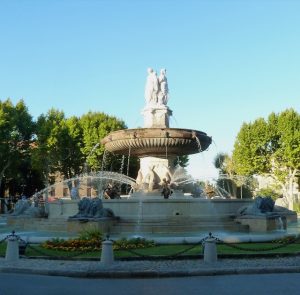Recorded history of Aix-en-Provence spans more than two millennium, which makes a sightseeing in this beautiful Southern France village a delightful stroll through the centuries. Founded in 122BC by Caius Sextius Calvinus, a Roman consul, Aix-en-Provence was first known as Aquae Sextiae with its natural warm thermal water springs serving as a grand spa retreat for the Romans. While many of the landmarks from this early era have unfortunately been lost due to destruction from countless battles for power over the years, some of the monuments have remained intact while still others are being rediscovered just beneath the surface. For example, in 2004 the Cathédrale Saint-Sauveur was found to have been built on what was a Roman forum in ancient times. Note: The cathedral itself took more than seven centuries to complete!
Sightseeing in Aix-en Provence Through Time
 Evidence of Aix-en-Provence’s evolution though the centuries is visible in the architecture along almost any rue or chemin. From the bell tower on Rue Espariat, to the abundance of fountains commissioned by wealthy patrons, to ruins of the Counts Palace dating from the 13th-century which have been recently uncovered as part of the renovation of the Place des Precheurs. The center of Aix-en-Provence is dissected by the Cours Mirabeau, a wide 17th-century avenue that leads to one of Aix’s most recognizable landmarks, the Fontaine de la Rotonde. To the south of the cours lies the Mazarin Quarter, and old town is to the north.
Evidence of Aix-en-Provence’s evolution though the centuries is visible in the architecture along almost any rue or chemin. From the bell tower on Rue Espariat, to the abundance of fountains commissioned by wealthy patrons, to ruins of the Counts Palace dating from the 13th-century which have been recently uncovered as part of the renovation of the Place des Precheurs. The center of Aix-en-Provence is dissected by the Cours Mirabeau, a wide 17th-century avenue that leads to one of Aix’s most recognizable landmarks, the Fontaine de la Rotonde. To the south of the cours lies the Mazarin Quarter, and old town is to the north.
For all its history and Provençal charm, contemporary Aix-en-Provence has managed to artfully blend its love-affair for the past with the modern amenities and conveniences upon which we’ve all come to rely. Free Wi-Fi hot-spots are available at most cafés and restaurants, and certainly all hotels in the area. You can even stop into the Apple Store or FNAC to pick up that extra phone charging cord that you forgot to pack.

